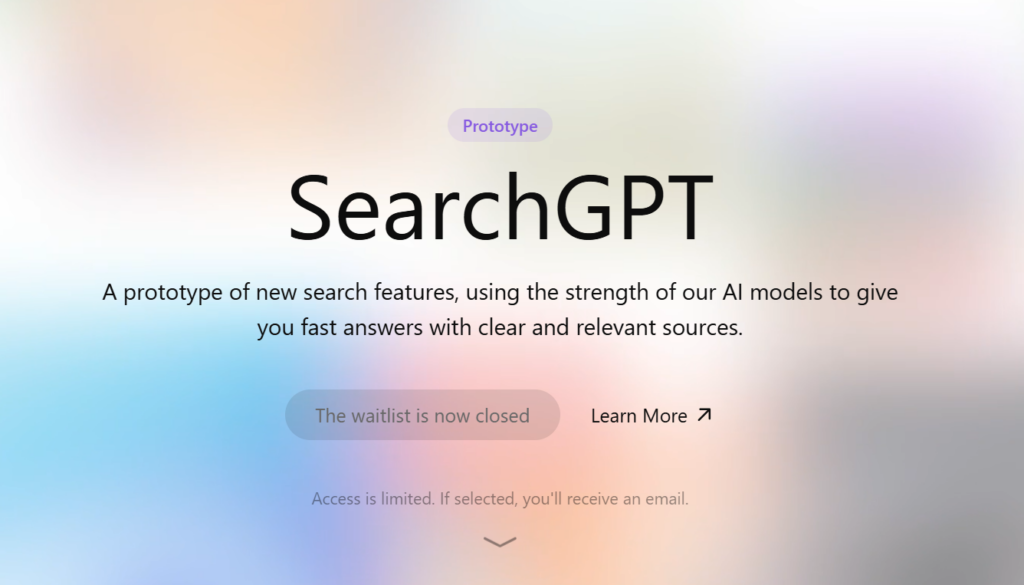
In recent years, artificial intelligence has become a key component of information technology. One innovative tool that has gained popularity in 2024 is SearchGPT. In this article we look at what exactly SearchGPT is, how it works and whether it is better than Google search.
What is SearchGPT?
SearchGPT to wyszukiwarka, która wykorzystuje sztuczną inteligencję (AI) for analysing and generating content in a way that resembles natural language. This model, based on GPT technology developed by OpenAI, is currently in the prototype phase. SearchGPT's aim is to provide users not only with links to sites, but also with ready-made answerswhich often resemble man-made content.
At the time of writing this article (October 2024) The waiting list for the use of SearchGPT is closed, which means that new users are currently unable to join.

How does SearchGPT work?
Its main objective is to providing information in a more conversational and interactive way than traditional search engines. It works by analysing the data entered and the context to generate responses that can be more personalised. This model can engage in longer conversations, which makes it useful in situations where the user needs clarification or additional information.
Is SearchGPT better than Google?
Google, jako najpopularniejsza wyszukiwarka na świecie, oferuje wiele zaawansowanych funkcji, takich jak wyszukiwanie głosowe czy lokalne wyniki. Google indeksuje miliardy stron internetowych, co provides users with access to a huge database. Its algorithms allow results to be filtered by timeliness, relevance and page reputation.
Does SearchGPT have a chance to trump Google?
Its emergence has left many people asking themselves: Can SearchGPT threaten Google?Although both solutions offer information retrieval, differ in their approach, modus operandi and strengths, Therefore, the answer is not at all obvious.
1. concrete answers
SearchGPT shines where a specific answer counts, without the need to sift through dozens of pages. When a question requires a more detailed explanation, this tool can provide a comprehensive answer right away, saving the user time. Google, on the other hand, still delivers results in the classic link form - you will find links to many sites in the results, but it is up to us to make a choice and look through them ourselves.
2. timeliness of data
For Google, timeliness is key - it indexes the internet continuously, which means that the results reflect the latest changes, articles and events. For SearchGPT, the issue is more complex, because in order to 'teach' it new information, it needs to be re-trained on new data. For this reason Google has an advantage in queries about the latest developments. With real-time content indexing, it can respond to news requests.
3. interactivity
Here SearchGPT has something that Google does not offer - the a more personal approach to the user. Rather than rigidly serving up results, as Google does, SearchGPT is able to have a 'conversation' and develop the topic depending on what we need.
Google takes a more technical approach to search - the user is presented with a set of results. In many cases this is a useful feature, However, quite a few people may appreciate the convenience of the dialogue, which SearchGPT offers.
4. Reliability of sources
Google gives you access to sources at your fingertips - the user can compare different sites, assess their reliability himself and make a choice on which to base his information. SearchGPT natomiast generuje odpowiedzi na podstawie ogromnych zbiorów danych, ale często bez bezpośredniego wskazania źródła. This can be a downside, especially with more complex questions, where we need detailed verification.
Summary
Both tools have their unique advantages, but also their limitations. SearchGPT will work well where it counts. receive a rapid response and be able to conduct a dialogue when in doubt. Google, on the other hand, will remain the first choice for those who need to the latest information and prefer to choose their own sources. In practice, each meets different user needs and, while SearchGPT is an interesting alternative, Google still has the edge in speed of access to the latest information.

 3 minutes reading
3 minutes reading


